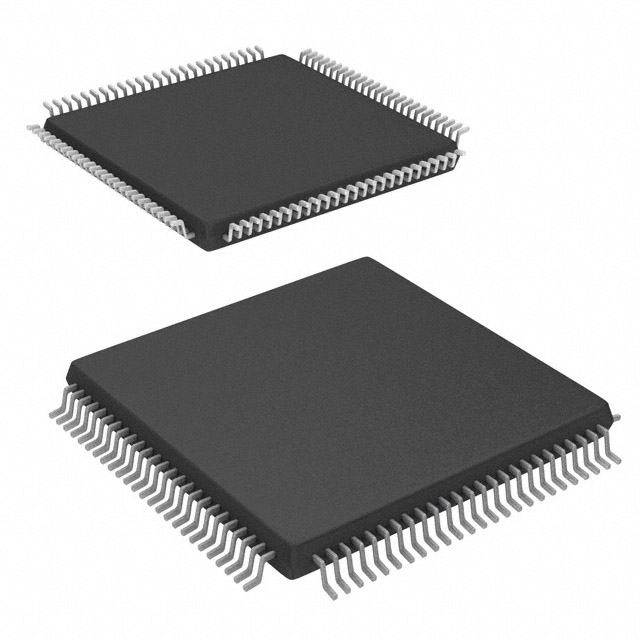ATMEGA1280-16AUR
Product Overview
The ATMEGA1280-16AUR belongs to the family of microcontrollers and is specifically categorized as an 8-bit microcontroller. It is widely used in various electronic applications due to its versatile characteristics, including its use in embedded systems, robotics, and industrial automation. The ATMEGA1280-16AUR comes in a compact package and offers essential features that make it suitable for a wide range of applications.
Basic Information
- Category: Microcontroller
- Use: Embedded systems, robotics, industrial automation
- Characteristics: Versatile, compact, high-performance
- Package: TQFP (Thin Quad Flat Package)
- Essence: High-speed processing and control capabilities
- Packaging/Quantity: Available in reels with varying quantities
Specifications
The ATMEGA1280-16AUR is equipped with the following specifications: - Architecture: 8-bit AVR - Flash Memory: 128 KB - SRAM: 8 KB - EEPROM: 4 KB - Operating Voltage: 2.7V - 5.5V - Digital I/O Pins: 86 - Analog Input Pins: 16 - Clock Speed: 16 MHz - Communication Interfaces: UART, SPI, I2C
Detailed Pin Configuration
The detailed pin configuration of the ATMEGA1280-16AUR includes the arrangement of digital I/O pins, analog input pins, power supply pins, and communication interface pins. This configuration enables seamless integration into various electronic circuits and systems.
Functional Features
The ATMEGA1280-16AUR offers the following functional features: - High-speed processing capabilities - Extensive digital and analog I/O options - Multiple communication interfaces for data exchange - On-chip peripherals for enhanced functionality - Low power consumption for energy-efficient operation
Advantages and Disadvantages
Advantages
- Versatile application in embedded systems and robotics
- Extensive memory and I/O capabilities
- Wide operating voltage range for flexibility
- High clock speed for rapid data processing
Disadvantages
- Limited compatibility with certain legacy systems
- Relatively higher power consumption compared to some low-power microcontrollers
Working Principles
The ATMEGA1280-16AUR operates based on the principles of embedded system design, utilizing its processing core, memory, and I/O capabilities to execute programmed tasks. It interacts with external components and sensors through its digital and analog interfaces, enabling control and data acquisition in various applications.
Detailed Application Field Plans
The ATMEGA1280-16AUR finds extensive application in the following fields: - Industrial automation systems - Robotics and motion control - Consumer electronics - Automotive electronics - Home automation and IoT devices
Detailed and Complete Alternative Models
For applications requiring similar functionalities, alternative models to the ATMEGA1280-16AUR include: - ATMEGA2560-16AU - PIC18F4550 - STM32F407VG
In conclusion, the ATMEGA1280-16AUR is a versatile microcontroller with extensive capabilities, making it suitable for a wide range of electronic applications. Its high-speed processing, ample memory, and diverse I/O options contribute to its popularity in the embedded systems and robotics domains. Despite some limitations, its functional features and wide application field plans make it a valuable component in modern electronic designs.
Word Count: 498
قم بإدراج 10 أسئلة وإجابات شائعة تتعلق بتطبيق ATMEGA1280-16AUR في الحلول التقنية
What is the ATMEGA1280-16AUR microcontroller used for?
- The ATMEGA1280-16AUR is commonly used in embedded systems and technical solutions requiring a high-performance microcontroller with numerous I/O pins and advanced features.
What are the key features of the ATMEGA1280-16AUR?
- The ATMEGA1280-16AUR features 128KB of flash memory, 8KB of SRAM, 86 general-purpose I/O pins, multiple communication interfaces (UART, SPI, I2C), and various built-in peripherals such as timers, PWM channels, and analog-to-digital converters.
How do I program the ATMEGA1280-16AUR?
- The ATMEGA1280-16AUR can be programmed using popular development environments such as Atmel Studio or Arduino IDE, utilizing C/C++ programming languages.
Can the ATMEGA1280-16AUR be used for real-time applications?
- Yes, the ATMEGA1280-16AUR is suitable for real-time applications due to its multiple timers, interrupt handling capabilities, and fast execution speed.
What voltage levels does the ATMEGA1280-16AUR support?
- The ATMEGA1280-16AUR operates at a voltage range of 1.8V to 5.5V, making it compatible with a wide variety of electronic components and power supplies.
Is the ATMEGA1280-16AUR suitable for low-power applications?
- While not specifically designed for ultra-low-power applications, the ATMEGA1280-16AUR offers power-saving modes and can be optimized for lower power consumption when necessary.
Can the ATMEGA1280-16AUR communicate with other devices?
- Yes, the ATMEGA1280-16AUR supports various communication protocols such as UART, SPI, and I2C, enabling seamless interaction with other microcontrollers, sensors, and communication modules.
What kind of technical support is available for the ATMEGA1280-16AUR?
- Technical support for the ATMEGA1280-16AUR is provided by the manufacturer, including datasheets, application notes, and community forums where developers can seek assistance and share knowledge.
Are there any known limitations or issues with the ATMEGA1280-16AUR?
- While generally reliable, some users have reported occasional issues with certain peripheral functionalities or specific operating conditions, which may require careful consideration during design and testing.
Where can I find resources for designing with the ATMEGA1280-16AUR?
- Resources such as reference designs, schematics, and example code for the ATMEGA1280-16AUR can be found on the manufacturer's website, as well as through online communities and technical forums dedicated to embedded systems and microcontroller development.


